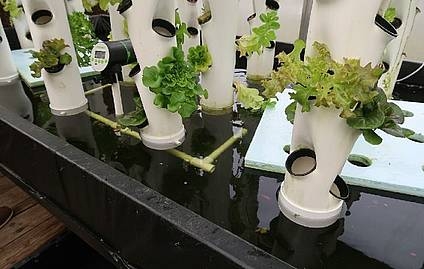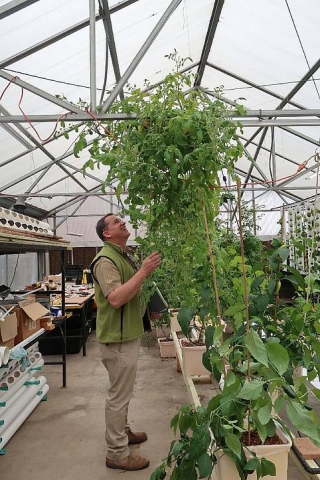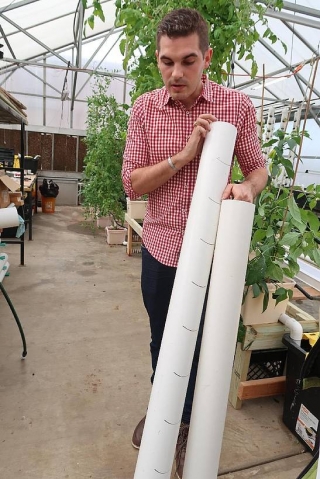
Planting veggies in a tube thwarts hungry bunnies while saving space and water. Hydroponic gardening, in a nutshell, is growing plants in a nutrient solution without soil, and aquaponics is growing plants and fish in a symbiotic relationship. While many think these are new, Space Age techniques, they have been around since the Hanging Gardens of Babylon. In hortimedia 30-03-2020
But soil-free gardening has come a long way in recent years. Hydroponic systems take many sizes and shapes, and there are vertical towers with many applications.
Vertical gardening is also not a new concept. When you stake your tomato plants or grow green beans on poles, you are saving space in the garden (and giving your plants better growing conditions) by growing them upright instead of letting them sprawl on the ground. Trellising vines is another way we garden vertically.
When you marry vertical gardening with hydroponic gardening, you get vertical towers. There are a lot of vertical tower systems on the market, but one Arkansan is taking the concept to a new level.

Agrowponics is a growing startup company that Gunnar Shaffer began as a research project when he was an undergraduate at John Brown University, majoring in engineering renewable energy power systems.
An Arkansas church asked one of his engineering professors to help them build a hydroponic food system for a Guatemala mission. It had to be totally off the grid, so it had to run on solar power or another nontraditional power source. As the only engineering student with any type of agricultural background (he grew up on a farm in the Hot Spring County town of Friendship), Shaffer took on the project, and it soared.
To maximize their use of space and grow as much food as possible in a smaller footprint, he designed vertical columns to support 20 or more plants at a time. He used products easily obtained at any hardware store to get going. The goal was a garden method that was cost-efficient and easily replicable, which could have a global impact.
He built the system for Guatemala but shared how to make it on a Youtube channel so others could make their own. His videos count nearly 2 million views and have been downloaded in more than 100 countries.
While all of his information on how to build your own tower is online, he has found that many people would rather buy a system than make their own. He set up Agrowponics LLC and is manufacturing Agrowtowers and kits of all sizes, including commercial-size systems.
In 2017, he joined forces with Tom Burns, an engineer who works with Shaffer in his full-time job at Southwest Power Pool. Burns became a partner in Agrowponics and has been instrumental in the production process and automation of the control systems. They acquired a CNC machine for precision cutting and an app whereby users can log-in to monitor their growing system remotely.
The basic tower, called the Agrowtower, is made of 4-inch food-grade PVC pipes with evenly spaced slots for the plants. Agrowponics opens these growing slots up and down the tubes using a heat forming process that is customized to the size of the plants desired.

Water is pumped to the top of each tower and falls through the Agrowtower, watering each individual growing pod. The water is constantly recycled, reducing water use by 90% — compared to normal farming.
The basic kit comes with one tower, a base to hold the water with a recirculating pump, the net cups in each hole in the tower and other small necessities to get started.
Agrowtowers work best for leafy greens, herbs and strawberries. If you want to grow tomatoes, peppers and other, larger vegetables, he offers a Dutch bucket system.
When we toured his greenhouse, we were amazed at the tomato plants he has grown. They went from seed to full production with plants that became 7 feet tall in nine weeks. We saw full heads of lettuce that grew in five weeks.
Click here for more information.
